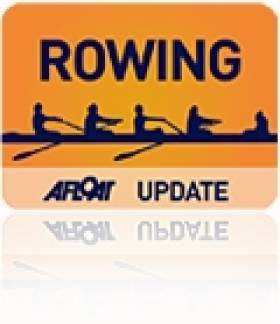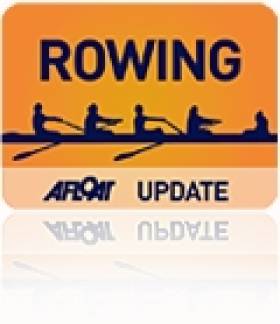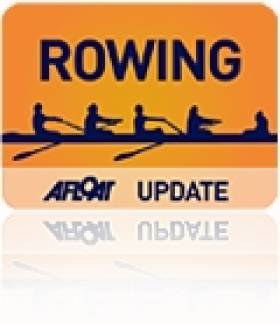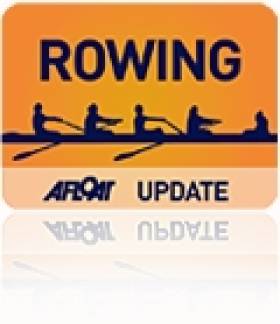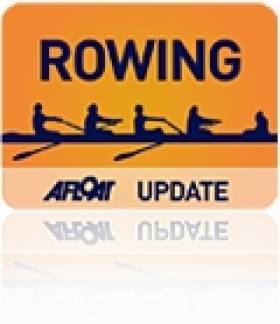Displaying items by tag: Henley Royal Regatta,
Henley Hopes Short-lived for Lady Elizabeth Crew
#Rowing: Henley Royal Regatta did not yield any early joy for Irish crews this morning. In the Wyfold Cup coxless fours, Lady Elizabeth were beaten by Nottingham Rowing Club ‘A’. The English crew cut across from their station at the start and took a lead which they did not relinquish. Lady Elizabeth tried hard in the warm conditions, but their young opponents held on to their lead and won by two and a half lengths.
Henley Royal Regatta, Day One (Irish interest)
Wyfolds (Fours, Club): Nottingham RC ‘A’ bt Lady Elizabeth BC 7 mins 39 seconds, 2½ l.
#ROWING: The Irish challenge in the Double Sculls at Henley Royal Regatta was ended this morning as the British national crew of John Collins and Jonathan Walton beat Dave Neale and Eimantas Grigalius of Three Castles. The British, who have been finalists at the European Championships and the World Cup in Aiguebelette, were half a length up by the top of the Island and three lengths up at 500 metres. The winner was never in doubt from that point.
Henley Royal Regatta, Day Three (Selected Results; Irish interest)
Double Sculls Challenge Cup (Men, Open): Leander (J Collins, J Walton) bt Three Castles (D Neale, E Grigalius) 2l, 7 mins 48 secs.
# ROWING: Sanita Puspure was beaten in the semi-final of the Princess Royal at Henley Royal Regatta this evening. The woman who will represent Ireland in rowing at London 2012 fought out a close duel with Isolda Penney of Canada, who was behind until the middle of the race. The Canadian, in the preferable Berks station, pushed into the lead and held off Puspure to eventually win by two lengths.
Penney’s victory was a surprise, but the 37-year-old, who holds joint US/Canadian citizenship, is a serious competitor. She was third in the US trial held before the Olympic Qualifier in Lucerne this year. The trial was won by Genevra Stone, who went on to finish third at the Qualifier, one place ahead of Puspure.
Kaisa Pajusalu of Estonia, who lost out in that Olympic Qualifier (she finished sixth in the Final) won the other semi-final of the Princess Royal after a good race with Laura Schiavone of Italy.
Henley Royal Regatta, Day Four (Irish interest):
Queen Mother (Quadruple Sculls, Open): Victoria City Rowing Club, Canada bt UCC/London RC (N Kenny, A English, H Pelly, M O’Donovan) 1¾ l, 7:24
Princess Royal (Single Sculls, Women, Open): I Penney (Canada) bt S Puspure (Ireland) 2l, 9:57
K Pajusalu (Estonia) bt L Schiavone (Italy) easily 10:03
Durham University Dash Queen's Hopes at Henley
# ROWING: Queen’s bowed out of Henley Royal Regatta yesterday after a very good race in the Visitors’ Cup with Durham University. The Queen’s four started well, but the bigger Durham crew headed them and won by three lengths.
Henley Royal Regatta, Day Three (Irish interest)
Princess Royal (Single Sculls, Women, Open): S Puspure (Old Collegians) bt P Whittaker (Nottingham) easily, 10.31
The Double Sculls (Open): SH Whelpley and WS Cowles bt A Boreman (Belfast Boat Club) and C Beck (RBAI) easily, 8:45.
Visitors’ Cup (Fours, Intermediate): Durham University bt Queen’s University 3l, 8:03.
# ROWING: John Keohane slugged it out with the heavier Luke Moon in the Diamond Sculls at Henley Royal Regatta today but finished second, a length off the Tideway Scullers’ man. Keohane was slower off the start, but he drew level in the middle stages and even edged in front. Moon eventually took and held the lead, but he slowed in front of the enclosures and Keohane tightened the final margin.
Henley Royal Regatta, Day Two (Irish interest)
Diamond Sculls (Single Sculls, Open): R Lopez (El Salvador) bt C Williamson (Queen’s University) easily, 9:00; L Moon (Tideway Scullers’ School) bt J Keohane (Lee Valley) 1l, 9:30
Visitors’ Cup (Fours, Intermediate): Queen’s University bt Nottingham University B easily, 8:14; Durham University bt Oxford University and Isis BC 4 ¼ l, 7:55
Wyfold Cup (Fours, Club): Rob Roy bt Cork BC 4¼ l, 7:53
Rob Roy End Cork's Run at Henley Royal Regatta
# ROWING: The Cork Boat Club four of John Paul Collins, Stephen Carroll, Colm Dowling and Shane Mac Eoin put in a good challenge in the second round of the Wyfold Cup but could not overcome Rob Roy from Cambridge at Henley Royal Regatta. The English crew led by half a length at the quarter mile and held off Cork’s pushes to extend their lead.
Colin Williamson of Queen’s University lost to El Salvador’s Roberto Lopez in the Diamond Sculls. Lopez powered away from Williamson early on and did not yield up the advantage.
Henley Royal Regatta, Day Two (Irish interest)
Wyfold Cup (Fours, Club): Rob Roy bt Cork BC 4¼ l, 7:53
Diamond Sculls (Single Sculls, Open): R Lopez (El Salvador) bt C Williamson (Queen’s University) easily, 9:00
# ROWING: Ireland’s only eight competing at Henley Royal Regatta bowed out of the Temple Cup today. Trinity led the University of Michigan at the Barrier and Fawley (roughly halfway). A push by Trinity was ineffective, but the Americans staged their own which took them into the lead. They took control and won by one and a quarter lengths.
Henley Royal Regatta, Day One (Irish interest)
Temple Cup (Eights, Student): University of Michigan (USA) bt Trinity 1 ¼ l, 7:12
Prince Albert Cup (Coxed Fours, Student): Imperial College bt Queen’s University 1¾ l, 8:07
Wyfold Cup (Fours, Club): Cork BC bt Cardiff City 1l, 7:52; Rob Roy bt Henley B 4l, 7:56
Cork Boat Club Win First Battle at Henley Royal Regatta
# ROWING: Cork Boat Club gave Ireland its first race win at Henley 2012, when they came through their first round test against Cardiff City in the Wyfold for club fours. The Cork crew eked out a lead early on, but Cardiff mounted a challenge right to the end when the pressure told and their steering faltered. Cork won by a length.
Imperial Boat Club, who were seeded, ousted Queen’s University in the Prince Albert for student coxed fours.
Henley Royal Regatta, Day One (Irish interest)
Temple Cup (Eights, Student): Brown University (USA) bt Dartmouth 2½ l, 6:57;
Prince Albert Cup (Coxed Fours, Student): Imperial College bt Queen’s University 1¾ l, 8:07
Wyfold Cup (Fours, Club): Cork BC bt Cardiff City 1l, 7:52; Rob Roy bt Henley B 4l, 7:56
# ROWING: In the qualifying races for Henley Royal Regatta this evening, UCD's senior women's eight was well outside the mark to qualify for the Remenham Cup, but Colin Williamson of Queen's University did enough to make his way into the draw for the Diamond Sculls for single sculls.


























